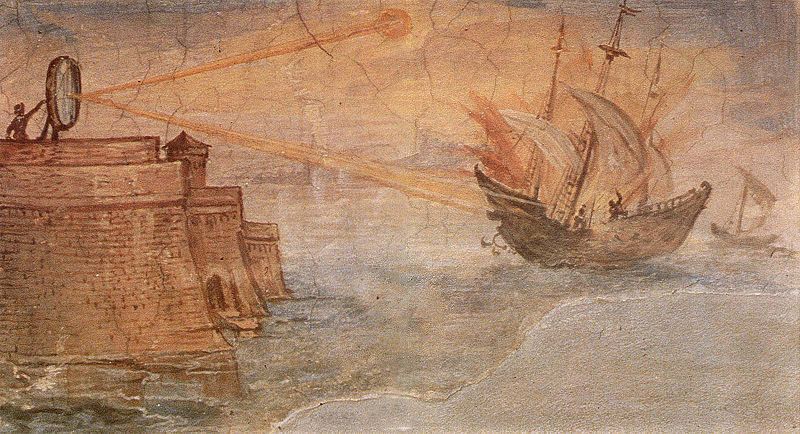
Did Archimedes use mirrors to power steam cannons when fighting against the Romans in the third century BC? That's the suggestion of Italian engineer Cesare Rossi, who has reconstructed how the solar-powered weapon could have worked. The result is ingenious, but historians of ancient technology are sceptical that it bears any relation to anything that Archimedes actually used.
I've just written a story on this for New Scientist, which includes a graphic showing Rossi's suggested design for the cannon. I didn't have room to put much into that story about what other scholars think of the idea, so I've discussed their reactions in a bit more detail below.
Archimedes is famous for supposedly inventing all kinds of wondrous war machines when the Romans laid siege to Syracuse, Sicily, where he lived. One of the most well-known stories, that he used mirrors to focus sunlight and set fire to enemy ships, seems extremely unlikely, even though modern reconstructions have shown this technique to be theoretically possible.
First, there aren't any sources from Archimedes' own time that tell this story. Sceptics also complain that to keep the sun's rays focused on a moving ship you would need to constantly change the mirror's curvature. And such fires would start very slowly, so those on board would presumably be able to extinguish them.
Rossi believes that another Archimedes legend throws new light on the burning mirror story. Several historical sources, including Petrarch in the 14th century and Leonardo da Vinci in the 15th century, wrote that Archimedes invented a steam-powered cannon, in which pressurised steam at the base of the gun forces a projectile out of the barrel at high speed. And the Greek historian Plutarch (46-120 AD) wrote that during the siege of Syracuse, the Romans saw something that was similar to a pole protruding from the city walls, and ran away shouting: "Archimedes is going to throw something on us now." Rossi says that could be a reference to a cannon.
Several teams have previously looked at whether or not this might work. But Rossi is suggesting a slight twist to the idea. At a conference on Archimedes in Syracuse last month, he suggested that mirrors focusing the sun's rays could have been used to heat the steam cannons. The cannons would then have been used to set fire to ships by hurling hollow projectiles filled with an incendiary fluid, perhaps a mix of sulphur, liquid bitumen, pitch and calcium oxide.
Rossi says this is a much more plausible use of burning mirrors than trying to set fire to distant ships. He points out that mirrors are used today to heat fluid to high temperatures in some applications of solar energy. He calculates that a cannonball measuring 20 centimetres across would have weighed around 6 kilograms and could have been fired from the gun at 60 metres per second, with a range of around 150 metres.
It's all intriguing speculation. But historians are not particularly impressed, mainly because, just as with the burning mirrors, there is no direct mention in the historical record of Archimedes inventing a steam cannon until many centuries after his death. Tracey Rihll, an expert in ancient science and technology from the University of Swansea, calls Rossi's idea an "interesting hunch" but says that to make a convincing case, Rossi would need to explain how writers such as da Vinci could have found out about Archimedes' invention. "Leonardo did have access to ancient texts," she says. "There is a paper about his thoughts on colour being directly influenced by the rediscovery of Aristotle's On Colours, for example. But a case needs to be made for something similar here."
Rihll also points out that many of the details that Rossi uses in his calculations are very different from the ones described by da Vinci. For example, da Vinci described a 25 kg solid iron ball, whereas Rossi considers a 6 kg ball made of hollow clay.
Another expert, Serafina Cuomo at Birkbeck College, University of London, has similar concerns. Reconstructions demonstrate a "technological possibility" she says, but don't constitute historical evidence: "We have a perfectly good explanation for later accounts that attribute steam cannons to Archimedes, and that is that Archimedes became a quasi-mythical icon of the scientist capable of constructing incredible weapons, and that in later medieval times some new weapons, ie cannons, did come onto the scene. Put the two together, and you have the story." Rihll agrees: "Archimedes' name attracts inventions to itself like moths to a flame."
Rossi admits that showing how the steam cannon could have worked "doesn't mean that it happened". But he adds that it is a much more likely use of burning mirrors than setting fire to ships directly. He doesn't have the funds to build a working model of the solar-powered cannon, but says that if anyone is interested, he can provide the technical drawings.
So, whether or not Rossi is right about the steam cannon, what other impressive weapons might Archimedes have employed against the Romans? The Greeks were certainly handy with a catapult. "Those of Archimedes' time could outperform [Rossi's steam cannon] in every department: payload weight, range, ease of use, reliability, health and safety," says Rihll. The idea that Archimedes invented a giant claw with which to attack ships is also plausible - Rihll believes that this is the most likely explanation of the pole-like device described by Plutarch. According to Cuomo, the closest invention to a steam cannon in ancient sources is a mention of a compressed air-operated catapult in Philo of Byzantium.